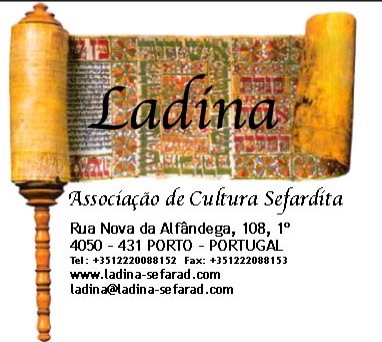2012/07/05
2010/12/23
 Photo by Rafael de Gilberto, courtesy Abraham Zacuto museum, Tomar
Photo by Rafael de Gilberto, courtesy Abraham Zacuto museum, TomarThe synagogue of Belmonte
by mlopesazevedo
The synagogue in Belmonte, Bet Eliahu was inaugurated on the 4th of December, 1996, 500 years after the edict of expulsion proclaimed on or about December 5, 1496, but never carried out; instead all Jews in Portugal were forcibly baptized in 1497. The noted author, Elias Lipiner estimates that about 40 persons were given permission to leave, including the king's physician and astrologer, Abraham Zacuto.
The Jews of Belmonte, who withstood nearly 300 years of the iron monster, the Inquisition (1536-1821), survived. Marrying amongst each other, outwardly Catholic, they secretly maintained the essentials of Judaism, the women transmitting prayers from mother to daughter while the men kept track of the Jewish calender and the high holidays. With the opening up of Portuguese society after the Carnation revolution of April 1974, and an article in the New York times in 1977 , world interest in the Marranos of Belmonte increased .
The first written reference to Jews in Belmonte is in the town's royal charter granted in 1199. Although the reference is not clear evidence of Jewish presence in Belmonte, there were Jewish communities in the nearby towns of Covilhã, Guarda, Gouveia and Trancoso. A stone found in 1910 by the “discoverer” of Marranos, a Polish mining engineer named Samuel Schwartz, probably belonged to the first synagogue of Belmonte. The Hebrew inscription dated 5057 (1297) from Habacuque 2.20 reads as follows:
“And Adonai is in his temple;
Sacred, silence;
Before him all the earth.”
The stone is presently in the municipal museum of Castelo Branco, a copy of the sone is on display in the Abraham Zacuto museum in the Tomar synagogue.
The inauguration of the new temple on December 4, 1996 represented a victory over the Inquisition, a victory of tolerance over evil, a symbol of the heroism and tenacity of the Marranos of Belmonte who clung to their Jewish identity against all odds. Following the approval of the municipal government, the first stone of the synagogue was laid in January 1993, witnessed by Dan Tichon, president of the Israeli parliament and other Jews from around the world. The guest of honour was Salomon Azoulay, whose financial generosity made the project possible.
Bibliography
Canelo, Augusto David, Os Últimos CriptoJudeus em Portugal, Camara Municipal de Belmonte,, 2d, 2001,
Garcia, Maria Antonieta, Judaísmo no Feminino, Tradição popular e ortodoxis em Belmonte,
Instituto de Sociologia e Etnogia das Religiões, Universidade Nova de Lisboa, Lisboa, 1999
2009/09/22
The Moon, Come to Earth: Dispatches from Lisbon
by Philip Graham
(four of the dispatches concern Luso-Jewish topics: "365 Days of Pork Surprise" (the difficulty of finding real alheiras in Lisbon), "We Capture the Castle" (which includes a visit to Belmonte's synagogue and Jewish museum), "Salvage" (which includes a visit to the Jewish section of the Praia cemetery in Cape Verde, and a meeting with the newly-minted Israeli ambassador), and "Three Churches," which uncovers the anti-semitism behind a Santarém church's "miracle," describes the São Domingos massacre of New Christians, and praises 16th Century playwright Gil Vicente for his critique of the Inquisition.) Part travelogue and part memoir, Philip Graham’s The Moon, Come to Earth brings us the news of Portugal past and present, touching on food and sports, religion and language, music and literature and art. Graham’s greatest strength is his ability to observe sharply and think clearly through the varied roles of public spectacle: the many ways in which the Portuguese tell stories of and to themselves through fireworks festivals and bullfights, medieval fairs and theater, magic shows and soccer matches and transformational public art. Given structure by his repeated return to the concept of saudade—‘a complicated feeling that combines sorrow, longing and regret, laced perhaps with a little mournful pleasure’—and given buoyancy by the ebullience of his voice, The Moon, Come to Earth shows Graham at the top of his game.
Part travelogue and part memoir, Philip Graham’s The Moon, Come to Earth brings us the news of Portugal past and present, touching on food and sports, religion and language, music and literature and art. Graham’s greatest strength is his ability to observe sharply and think clearly through the varied roles of public spectacle: the many ways in which the Portuguese tell stories of and to themselves through fireworks festivals and bullfights, medieval fairs and theater, magic shows and soccer matches and transformational public art. Given structure by his repeated return to the concept of saudade—‘a complicated feeling that combines sorrow, longing and regret, laced perhaps with a little mournful pleasure’—and given buoyancy by the ebullience of his voice, The Moon, Come to Earth shows Graham at the top of his game.
—Roy Kesey, author Nothing in the World and All Over
Labels: alheiras, Belmonte, books, Dispatches from Lisbon, Lisbon, philip Graham




